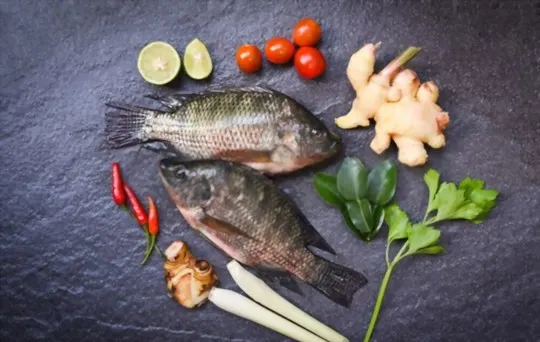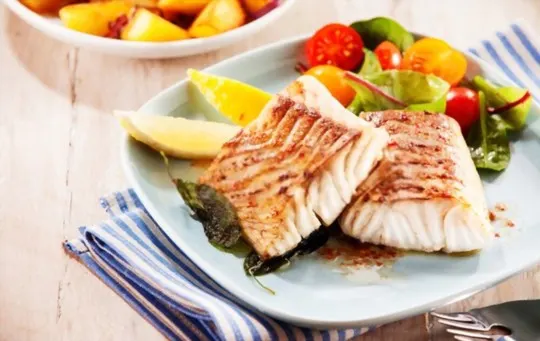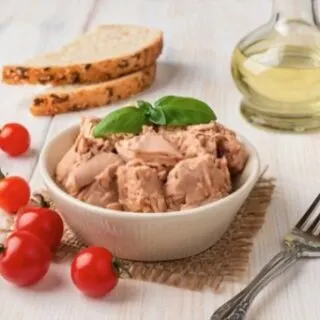Do you often find yourself reaching out for that can of tuna while cooking but have recently had to look for substitutes? You’re not alone.
This article will help solve the problem by giving you an insight into what tuna is and some delicious alternatives.
Get ready to discover the world of tuna substitutes.
What is Tuna?

Tuna is a type of saltwater fish that is extremely popular in many parts of the world.
It has a light, flaky texture and mild flavor, which makes it an ideal ingredient in sandwiches, salads, casseroles and other dishes.
Tuna can be found fresh or canned, making it one of the most widely available seafoods.
It is also one of the most nutritious sources of protein and omega-3 fatty acids.
Tuna contains high amounts of essential vitamins and minerals such as Vitamin B12, phosphorus and iron, which are essential for good health.
In addition to being high in protein, tuna provides numerous health benefits due to its content of omega-3 fatty acids.
These beneficial fats have been shown to protect against heart disease and reduce inflammation.
Despite its nutritional benefits, there are certain risks associated with consuming tuna that should be considered before adding it to your diet.
Tuna harvested from certain areas may contain mercury or polychlorinated biphenyls (PCBs), both potentially hazardous substances that can cause serious health problems when consumed in large amounts over extended periods of time.
Fortunately for those who love the flavor but are looking for alternatives to tuna with fewer risks, there are many other options open to them.
How to Cook Tuna?
Tuna is a popular fish that can be cooked in a variety of ways.
It is low in calories and fat, and contains high levels of the beneficial omega-3 fatty acids.
The most popular form of tuna is canned, but fresh tuna can also be purchased at many seafood stores.
In addition to being eaten raw or cooked on the stovetop, tuna can also be grilled, baked, smoked or seared.
When purchasing fresh tuna for cooking, select fillets that are moist and evenly cut.
There should be no browning or yellowing spots on the flesh that indicate spoilage.
When it comes to preparing tuna for cooking, make sure your fillets are dry before beginning — pat them gently with a paper towel to remove any moisture sitting on the surface.
To maximize flavor and prevent sticking, lightly rub the surface of your fillets with olive oil before seasoning them with salt and pepper.
Use rubber gloves while handling the fish to avoid transferring bacteria from your hands onto uncooked food surfaces — this will help keep you safe from foodborne illness.
When grilling or baking your tuna fillets, use medium-high heat and sear each side for 2-3 minutes until opaque.
Avoid over-cooking as this will make your fish dry and chewy — you’ll know it’s fully cooked when flakes break away easily after prodding it lightly with a fork or knife tip.
For added flavor and moisture retention during cooking time, brush each side of the fish lightly with butter before placing it into the oven or grill.
Serve up your freshly cooked tuna steaks alongside some light vegetables and grains for an easy yet satisfying meal.
5 Best Tuna Substitutes to Consider
For those looking to substitute tuna, there are a variety of delicious and nutritious alternatives.
From meaty proteins to vegan-friendly options, these five substitutes for tuna offer an opportunity to enjoy unique flavors and health benefits.
1 – Salmon

One of the best replacements for tuna is salmon.
While not exactly a nutritional powerhouse like tuna, salmon boasts a great flavor and texture combination that many find to be just as satisfying as tuna.
It is also packed with healthy omega-3 fatty acids, which makes it an excellent alternative to the unhealthy fats found in some canned tunas.
For those looking for higher omega-3 content and a closer texture alternative to traditional canned tuna fish, albacore or yellowfin are both excellent choices.
Make sure you source sustainable fishing practices when buying any type of seafood.
Additionally, look out for mercury and PCB levels as both can be present at significantly higher levels than found in other seafoods such as salmon, clams, cod and tilapia.
2 – Trout

Trout is easily one of the best alternatives to tuna due to its mild flavor and firm texture, which makes it great for preparing both hot and cold meals.
It’s a great source of protein, omega-3 fatty acids, phosphorus, selenium and more.
Its flavor pairs well with creamy sauces or Mediterranean flavors like olives, fennel and tomatoes.
Trout can be grilled or seared with ease—for a really impressive presentation try flipping a whole fish.
It can also be roasted in the oven tucked inside a bed of parchment paper or roasted vegetables for an easy dinner at home.
3 – Tilapia

Tilapia is a popular fish choice for those looking for a fish alternative to tuna.
It is both mild in flavor and low in fat, and can be cooked in a number of ways.
You can use tilapia as a tuna replacement in any recipe that calls for it, such as tuna casserole or tartar sauce.
You’ll want to be sure to choose fresh, white-fleshed fillets when you make your substitution, as the pinkish-gray flesh of the tilapia will impact the flavor of your dish.
Additionally, you must consider how you prepare it when using tilapia as an alternative for tuna – if you deep fry or cook it with butter and oil, it’s going to have an unhealthy texture and taste similar to fried chicken – not exactly what you’d expect from tuna.
4 – Mahi Mahi

Mahi Mahi is a small, slim fish found in warm temperate, subtropical, and tropical waters around the world.
While it’s originally known as a “poor man’s fish” due to its low cost, mahi mahi offers a mild flavor along with a firm texture that makes it one of the best substitutes for tuna.
In addition to being tasty, Mahi Mahi is similar in nutrition to tuna and includes Vitamin B6 and B12, niacin, and phosphorus – making it an excellent addition to healthy diets.
Mahi Mahi has a white flesh that will remain deliciously moist when baked or grilled.
Use this flaky fish to make salads, sandwiches or tacos.
Crispy mahi-mahi tacos with black beans is one crowd favorite dish that you can enjoy in under thirty minutes.
5 – Pollock

Pollock is a white fish with a delicate flavor.
It has the highest omega-3 content of all white fishes and is extremely low in mercury.
Pollock are found in the Atlantic and Pacific oceans, although some processes pollock from the Russian coast.
Pollock can be cooked in many different ways, including baking, frying, grilling or steaming.
It’s a great substitute for tuna as it’s less expensive but still provides the same nutritional benefits.
Pollock fillets have a subtle sweet flavor that many people love and they can be made into solid pieces for baking or crushing into chunks to top salads or casseroles.
Conclusion
Whether you’re avoiding tuna for health reasons, taste preferences, or ethical concerns, the five substitutes we’ve discussed are sure to satisfy your seafood cravings.
Tempeh can provide a delicious “meaty” texture and is a good source of protein and probiotics.
Canned salmon is an easy option that still contains all of the same benefits as canned tuna, but without the addition of mercury.
Many plant-based products also provide similar flavor profiles to traditional canned tuna while adding additional nutrition to your meal.
While it won’t add any fishiness or “meatiness”, nutritional yeast flakes can create a rich umami taste in dishes like salads or wraps.
For the ultimate convenience, try out pre-made salads to enjoy on the go.
For those who are looking for new ways to enjoy their favorite ingredients without having to worry about mercury levels or animal welfare, these five substitutes could be true lifesavers.

5 Best Tuna Substitutes to Consider
Ingredients
- 1 – Salmon
- 2 – Trout
- 3 – Tilapia
- 4 – Mahi Mahi
- 5 – Pollock
Instructions
- Choose your preferred substitute from the list of options.
- Organize all of your ingredients.
- Use the proper substitute to cook your recipes.

Carrie is a food writer and editor with more than 15 years of experience. She has worked for some of the biggest names in the food industry, including Bon Appétit, Food & Wine, and Martha Stewart Living.
As the Editor in Chief of IntroChicago.com, Carrie oversees all of the content on the site. She also manages the team of contributing writers and editors, who help to create delicious recipes, helpful tips, and informative articles that you’ll find on the site.
A native of the Chicago area, Carrie is passionate about all things food. She loves trying new restaurants and experimenting with new recipes in her kitchen. She’s also a graduate of the Culinary Institute of America, so she knows a thing or two about food!
